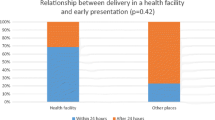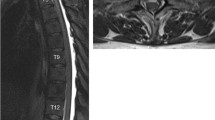Abstract
Introduction
A 2,796-gram male baby was born at 40 weeks gestation by vaginal delivery. Soon after, he was admitted at our department for treatment of a dorsal appendage.
Results and discussion
Magnetic resonance (MR) imaging showed a low-position spinal cord, skin-covered myelomeningocele, syringomyelia, and a tethered cord. Resection of the caudal appendage and tethering tissue was performed 22 days after birth under electrophysiological monitoring. Histopathological examination of the caudal appendage that was covered with skin revealed the presence of spinal cord tissue and peripheral nerve tissue. The string-like tethering tissue that extended from the spinal cord to the caudalis was a nerve root, and there was fiberization of the caudalis. The syringomyelia was improved at postoperative MR imaging. To our knowledge, there is no report of a similar case in the literature. We report rare combination of myelomeningocele and spinal cord tethering by aberrant nerve root with thoracic syringomyelia.






Similar content being viewed by others
References
Ames MD, Schut L (1972) Results of treatment of 171 consecutive myelomeningoceles. Pediatrics 50:466–470
Bui CJ, Tubbs RS, Oakes WJ (2007) Tethered cord syndrome in children: a review. Neurosurg Focus 23:1–9
Chakrabortty S, Oi S, Yoshida Y, Yamada H, Yamaguchi M, Tamaki N, Matsumoto S (1993) Myelomeningocele and thick filum terminale with tethered cord appearing as a human tail. Case report. J Neurosurg 78:966–969
Erkan K, Unal F, Kiris T (1999) Terminal syringomyelia in association with the tethered cord syndrome. Neurosurgery 45:1351–1360
Ersahin Y, Mutluer S, Kocaman S, Demirtas E (1998) Split spinal cord malformations in children. J Neurosurg 88:57–65
Lin PJ, Chang YT, Tseng HI, Lin JY, Huang YS (2007) Human tail and myelomeningocele. Pediatr Neurosurg 43:334–337
Lu FL, Wang PJ, Teng RJ, Yau KI (1998) The human tail. Pediatr Neurol 19:230–233
McLone DG, Nadich TP (1985) Terminal myelocystocele. Neurosurgery 16:36–43
Selcuki M, Vatansever S, Inan S, Erdemli E, Bagdatoglu C, Polat A (2003) Is a filum terminale with a normal appearance really normal? Childs Nerv Syst 19:3–10
Yamada S, Won DJ, Pezeshkpour G, Yamada BS, Yamada SM, Siddiqi J, Zouros A, Colohan AR (2007) Pathophysiology of tethered cord syndrome and similar complex disorders. Neurosurg Focus. 23:1–10
Author information
Authors and Affiliations
Corresponding author
Rights and permissions
About this article
Cite this article
Utsuki, S., Yamada, M., Yamazaki, T. et al. Spinal cord tethering by aberrant nerve root in myelomeningocele: case report. Childs Nerv Syst 25, 701–705 (2009). https://doi.org/10.1007/s00381-008-0801-7
Received:
Revised:
Published:
Issue Date:
DOI: https://doi.org/10.1007/s00381-008-0801-7




